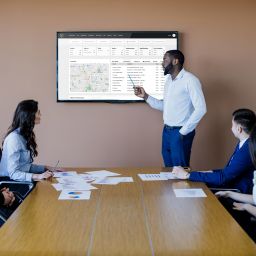7 Ways To Improve Employee Relations Management
Employee relations management is the effort done by companies and HR experts to keep their team members happy and productive. The goal is to keep a good and productive work atmosphere where everyone contributes to the achievement of organizational goals while also improving personally and professionally.
Employee relations management has grown even more crucial in recent years, since recent events have put a lot of strain on employer-employee relations in both large and small firms.
- Because of the COVID-19 pandemic, there has been a significant movement towards hybrid and remote work, forcing many human resources teams to find out new ways to stay engaged with their workers without physical presence.
- Many left their employment during the Great Resignation in quest of a better quality of life and more satisfying work experiences.
- There have been enormous layoffs as corporations try to adjust to a changing economy as a result of inflation, war, and an imminent recession.
Having an effective employee relations strategy brings about a number of benefits:
- Employee buy-in of company goals: Workers form a stronger bond with the company culture and take ownership of the organization’s common aims and objectives.
- Employee engagement: A healthy relationship between the HR department and employees leads to higher levels of motivation, initiative, and employee performance.
- Employee retention: Good employee relations increase job satisfaction, increasing the likelihood that your staff will want to stay.
1. Prioritize effective communication
The foundation of any strong relationship is honest and open communication, and the same is true for creating effective employee connections. Good communication builds bridges between employees and management, fostering an environment in which everyone’s needs are met.
Don’t just go with a vague “open door policy” (every employee’s worst nightmare). Schedule regular check-ins with personnel and even entire teams. This decreases the likelihood of unfavorable working events spinning out of hand.
Good communication is critical in creating an internal process that brings out the best in all parties, making it easier for everyone to generate high-quality work. From firm leadership and HR managers to the rest of the staff, there should be empathy and understanding of everyone’s experiences and needs.
2. Tell everyone the organization’s mission and vision
Your goal and vision should not be something that new workers read on a slide during onboarding and then forget. It is critical that they are ingrained in your company’s daily operations and explained in your employee handbook.
Regularly share and discuss your corporate values to ensure that everyone is on the same page. Your team has to understand how their job is directly tied to the implementation and achievement of the company’s goals and strategic vision.
Any changes to the organization’s vision, goal, or overarching policy should be communicated clearly and promptly. This promotes a transparent atmosphere and reinforces open communication throughout the team.
3. Give regular feedback
Providing and receiving constructive feedback is an essential component of building strong employee relationships. Workers must be encouraged to provide comments on their working conditions. They must also receive regular feedback and recognition for their efforts.
Employees are 2.7 times more likely to be engaged if they sense their efforts will be recognized. According to a SHRM poll, adopting recognition events enhances employee retention and helps to recruit new hires.
Get regular input from your staff on how they feel about their jobs, the direction the firm is taking, and any suggestions for development. This could be accomplished using focus groups, anonymous questionnaires, or even entry and exit surveys.
You can also use Vigilink.co.uk’s shift feedback feature to collect and offer comments after each workday.
When an employee does an excellent job, it is crucial to recognize and appreciate them. The type of appreciation you provide an employee is determined by the status of your organization as well as the preferences of that specific employee. Your expression of gratitude might be made public via employee recognition software, a weekly email, or even a LinkedIn endorsement. You can also recognize good work with incentives such as bonuses or extra time off, team building activities, or stipends for health and wellness initiatives.
4. Train leaders in conflict management
- Keep an eye out for early warning signals of a conflict so you can intervene before it escalates. A reduction in work quality, an unusually high number of sick days, or requests to change teams are examples of such indicators.
- Talk with each side and take the time to understand not only what occurred, but also why it occurred.
- Be mindful of how you phrase your questions. Avoid wording inquiries in a way that assigns guilt to one or both parties. Instead of asking, “Why did you yell at X at service yesterday?” instead, “Can you tell me more about what happened between you and X yesterday?”
- Make final choices in accordance with business values and procedures. This is vital in instances where it is impossible to find a solution that will satisfy all parties. It is also critical to document the case and the conclusion, as well as an explanation of why you reached your judgement. It is also critical to disclose the reasons for this decision to all stakeholders and to be open to receiving feedback.
5. Work on employees’ career development
Taking an active interest and role in the professional development of your team is a definite method to increase employee happiness and boost employee relations. Increasing the professional horizons of your workers also implies that they will be better qualified and equipped to deal with challenging situations, such as unanticipated, understaffed shifts.
There are several approaches you can take. You can provide mentoring programmes, on-the-job opportunities to work shifts they do not ordinarily work, tuition reimbursement for courses, or send them to conferences.
Assessing, tracking, and managing employees’ talents is one of the most practical ways to develop them. Employees benefit by explicitly identifying and tracking the abilities they need to improve their productivity and, in the long term, their careers.
6. Offer more flexibility
Workplace flexibility is becoming increasingly vital for employees today. According to studies, job flexibility leads to improved productivity and greater connection to the office culture. It is also an excellent method of reducing employee absenteeism. Flexibility in shift-based work is best achieved through collaborative scheduling.
Shift bids and shift swaps are two types of collaborative scheduling. Shift bids are when management post a number of open shifts and employees can bid on the ones they desire. Employees can request replacements on an ad hoc basis, subject to a manager’s approval.
If you’re still using spreadsheets and decentralized communication, providing flexibility among shift workers can become complicated and messy. Thankfully, cloud-based workforce scheduling software exists to ease the whole process.
7. Encourage employee work-life balance
Workers who have a strong work-life balance are content and fulfilled both at work and at home. They are more involved at work while still having time and energy to devote to their personal and family lives.
According to the World Health Organization, an individual’s work experience can be either beneficial or detrimental to their mental health. Employees are happier, healthier, and more productive in a company that recognises their needs both within and outside of the job.
Companies must engage with their employees on a frequent basis in order to diagnose and overcome situations of burnout, which may be physically and psychologically damaging.
Managers and human resource experts can help their workers achieve a better work-life balance by providing them with adequate time and energy outside of work. Companies can also invest in employee wellness in a variety of ways.
It is critical to have processes in place at work that reduce workplace stress and increase happiness and productivity. Human resource management software, such as Vigilink WFM, can assist managers in creating more effective, less stressful work environments by improving scheduling and staff communication.
Streamline employee relations management with Vigilink.co.uk
Employee relations is a highly human undertaking. Having said that, technology can help to streamline many of the processes required to efficiently manage employee interactions. Vigilink.co.uk provides solutions such as AI-powered flexible scheduling, labour forecasts to reduce under or overstaffing, and improved employee communications.

















